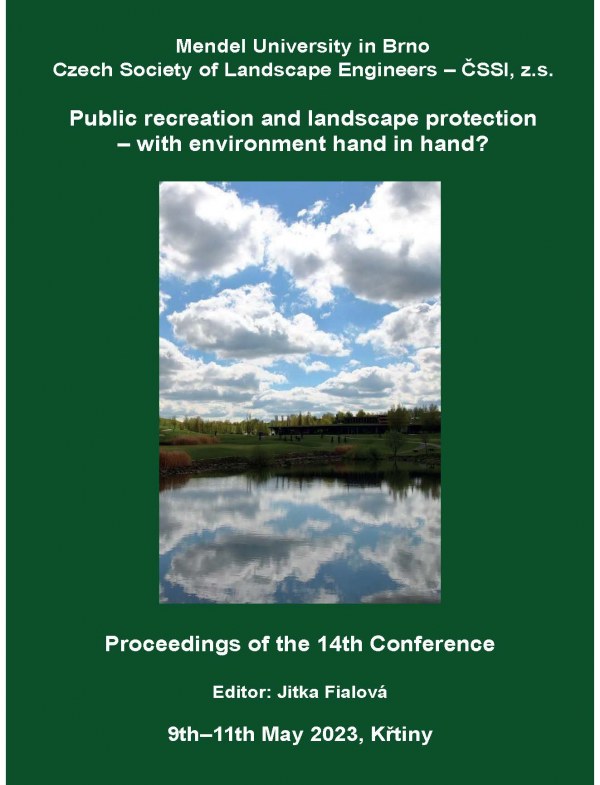
DOI: 10.11118/978-80-7509-904-4-0163
MID-FIELD WOODLOTS AS A SUBSTITUTE FOR FORESTS IN AGRICULTURAL AREAS - THE IMPACT ON ENVIRONMENT AND TOURISM
- Beata Fortuna-Antoszkiewicz, Jan Łukaszkiewicz, Piotr Wisniewski
In vast agricultural areas, afforestation systems - mid-field, roadside, waterside and others - are a necessary "substitute" for former natural forest complexes. They contributed to preserving the ecological balance in areas intensely anthropogenically transformed centuries ago. Systemically introduced and constantly maintained, they bring many benefits for people and the environment - they fulfil several diverse functions - from biological and technical to aesthetic and social. Afforestation strongly impacts the climate, translating into economic efficiency in agricultural areas; it significantly reduces environmental pollution (phytoremediation); they have a biocenosis function (shaping specific biotopes); they positively affect landscape physiognomy. In Europe, the protection of landscape and natural resources is implemented through several legal acts at the level of EU legislation and individual countries. In 2020, the European Commission published a biodiversity strategy for protecting and restoring nature in the European Union by 2030. The document also refers to mid-field plantings because this issue remains at a different level in individual countries.
Keywords: mid-field afforestation, ecological corridors, environmental impact, rural areas, recreation and tourism values, woodlots
pages: 163-168, Published: 2023, online: 2023
References
- Act of April 16, (2004). on nature protection, Journal of Laws 2018, item 1614, as amended, Poland [Ustawa z dnia 16 kwietnia 2004 r. o ochronie przyrody. Dz. U. 2018, poz. 1614 z póŒn. zm.)].
- Album on the occasion of the National Tree Arrangement Meeting, Kielce, September 14-15,1964. Unpublished materials, col. Private.
- Bell, J. N. B., Treshow, M. (2004). Air pollution and plant life. Wyd. Naukowo-Techniczne, Warsaw.
- Bogdanowski i in. 1979. Bogdanowski, J., Łuczyńska-Bruzda, M., Novák, Z. 1979. Landscape architecture [Architektura krajobrazu]. Ed. PWN, Warszawa-Kraków.
- EU Biodiversity Strategy 2030: Bringing nature back to our lives [COM(2020)0380], of May 20, 2020.
- Fortuna-Antoszkiewicz B., Łukaszkiewicz J. (2012). Fruit trees plantings along roads in Poland - tradition and present (19th / 20th century). Czasopismo Techniczne, 30(109), 127-136.
- Fortuna-Antoszkiewicz, B., Łukaszkiewicz, J. (2016). Genesis and characteristics of woodlot forms in the landscape of southern England. Nauka Przyroda Technologie 2016, Vol. 10, Issue 4, #50, 1-18.
 Go to original source...
Go to original source... - Fortuna-Antoszkiewicz, B., Łukaszkiewicz, J. (2017). Fruit alleys - the way of historical rural landscape creation in Poland. Mičkininkystė Ir Kračtotvarka, Forestry And Landscape Management,1 (12), 15-24.
- Fortuna-Antoszkiewicz, B., Łukaszkiewicz, J. (2018). The historic alley complex in Radziejowice - th cultural heritage of Mazovia. Evaluation of the state of preservation and value of the object [Zabytkowy zespół alej w Radziejowicach - kulturowe dziedzictwo Mazowsza. Ocena stanu zachowania i warto¶ci,obiektu]. MAZOWSZE Studia Regionalne, No 24, 63-83.
 Go to original source...
Go to original source... - Fortuna-Antoszkiewicz, B. Łukaszkiewicz, J., Wi¶niewski, P. (2018). Preservation status and landscape values of poplar plantations of the Żerański Canal - a methodological case study [Stan zachowania i walory krajobrazowe przywodnych zadrzewień topolowych Kanału Żerańskiego - metodologiczne studium przypadku]. MAZOWSZE Studia Regionalne, No 2018/27, 81-102.
 Go to original source...
Go to original source... - Fortuna-Antoszkiewicz, B., Łukaszkiewicz, J., Rosłon-Szeryńska, E., Wi¶niewski, P. (2019). Fruit alleys in rural landscape - in Poland and Moravia. In: Fialová, J. (Ed.). Public recreation and landscape protection - with sense hand in hand... Conference proceeding, Kűtiny, 13th-15th May 2019, pp. 162-167.
- Graffstein, I. (1989). Shaping green areas in the vicinity of roads [Kształtowanie terenów zieleni w otoczeniu dróg]. Transprojekt, Centralne Biuro Projektowo-Badawcze Dróg i Mostów, Warsaw.
- Hejmanowski, S., Milewski, J., Terpiński, Z. (1964). The tree-grower's guide [Poradnik zadrzewieniowca]. PWRiL, Warsaw.
- Hejmanowski, S. (1975). Cultivation of poplars [Uprawa topoli]. PWRiL, Warsaw.
- Karg, J., Karlik, B. (1993). Afforestation in rural areas [Zadrzewienia na obszarach wiejskich]. Zakład Badań Šrodowiska Rolniczego i Le¶nego PAN, Poznań.
- Karg, J. (2003). Mid-field plantings, buffer zones and field margins. Agri-environmental programme [Zadrzewienia ¶ródpolne, strefy buforowe i miedze. Program rolno¶rodowiskowy]. The Ministry of Agriculture and Rural Development, Warsaw.
- Łuczyńska-Bruzda, M. (1995). Afforestations in an open landscape. Ecological and cultural reasons for afforestation in an agricultural landscape in the light of the literature on the subject. Ed. OOZK Narodowa Instytucja Kultury, Warsaw.
- Niemirski, W. (ed.). (1973). Shaping green areas [Kształtowanie terenów zieleni]. Arkady, Warsaw.
- Norma branżowa (BN-76) 9212-02: Materiał sadzeniowy, sadzonki drzew i krzewów do upraw le¶nych, plantacji i zadrzewień, 1976 [Industry standard (BN-76) 9212-02: Planting material, seedlings of trees and shrubs for forest cultivation, plantations and afforestation, 1976].
- Statistical Yearbook of Forestry and Wood Industry 1966 [Rocznik Statystyczny Le¶nictwa i Przemysłu Drzewnego 1966].
- Sadowiec K., Gawroński S. (2013). Usefulness of selected linden species (Tilia sp.) for phytoremediation of air from dust pollution. Woda-Šrodowisko-Obszary Wiejskie, Vol. 13, Issue 3(43), 131-148.
- Strzelecki, W., Sobczak, R. (1972). Afforestation of wasteland and land difficult to renew [Zalesianie nieużytków i gruntów trudnych do odnowienia]. Ed. PWRiL, Warsaw The European Landscape Convention, Journal of Laws of 2006 No. 14, item 98.
- Zaj±czkowski, K., Górka, W. (1979). Principles of afforestation management [Zasady gospodarki zadrzewieniowej]. Documentation: Instytut Badawczy Le¶nictwa, Warsaw.


